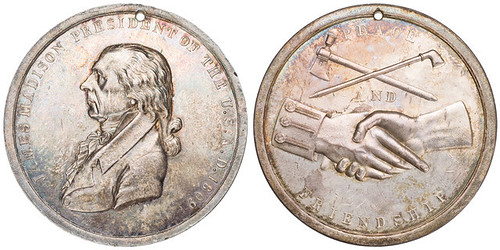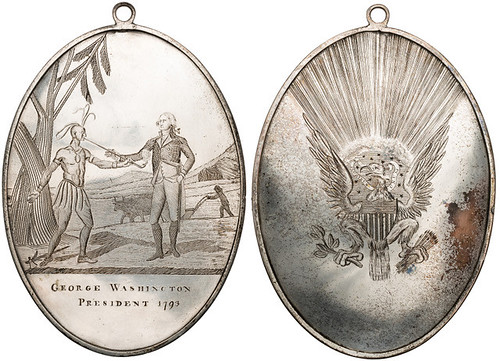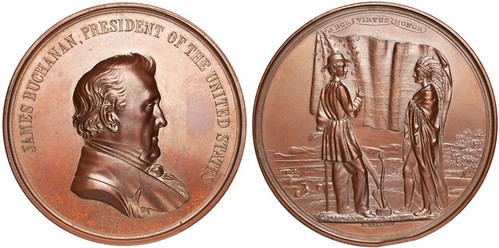
PREV ARTICLE
NEXT ARTICLE
FULL ISSUE
PREV FULL ISSUE
V25 2022 INDEX E-SYLUM ARCHIVE ANS INDIAN PEACE MEDAL COLLECTIONAn ANS Pocket Change blog article by Oliver Hoover examines the development of the Indian Peace Medal collection at the ANS. Here's an excerpt - see the complete article online. -Editor When looked at through the numismatic lens, the Indian peace medals in the extensive collection of the American Numismatic Society tell the interesting and sometimes sordid story of the development of the U.S. Mint as both producer and marketer of medals for official purposes and for collectors. Due to the association of many of the medals with the names of Native American leaders who owned them before they entered the ANS collection, the medals also tell the personal stories of triumph and tragedy experienced by their original owners. The medals also have a third facet that is often overlooked. Their accession histories tell the story of the early American Numismatic Society and of the extraordinary cast of characters who came together for the purpose of developing the Indian peace medal collection between 1883 and 1927. The often-collective nature of the work undertaken by members of the Society in this period illustrates the broad interest of the material to people not only as numismatists, but as Americans with a sense of their country's history. Figure 1. Small silver James Madison Indian peace medal donated by Daniel Parish, Jr The first original silver peace medal to enter the collection was a James Madison of the small size normally reserved for distribution to leading Native American warriors than to important chiefs (Fig. 1). It was included along with 29 U.S. Mint restrikes of Indian peace medals in bronzed copper and white metal donated by Daniel Parish, Jr. in 1883. Parish had been a prominent member of the Society since 1865 and assumed the office of President in the same year as his gift of the peace medals. He continued to guide the ANS until ill health caused him to retire from office in 1896. His leadership was so widely appreciated by the council and the membership that he was elected Honorary President for Life in 1908. He not only provided the constitution upon which the Society would advance into the future, but also lay the foundation of the ANS collection of both original medals and Indian peace medal restrikes. Upon these first 30 medals the Society would ultimately build the largest institutional collection of Indian peace medals in the world. Figure 2. Large oval silver George Washington Indian peace medal donated by Stephen H. P. Pell. Daniel Parish, Jr. died in 1914, but the spirit of his 1883 gift lived on and seems to have taken a greater hold on the Society. At the end of 1914 and continuing through 1915, the ANS acquired the important collection of original silver Indian peace medals formed by Stephen H. P. Pell. He had been a member of the Society since 1907 and is perhaps best known for his restoration of Fort Ticonderoga in upstate New York. Upon determining that the proper place for the medals was in the ANS cabinet, Pell donated five pieces outright, including an impressive engraved 1793 George Washington oval medal (Fig. 2) and then took the novel step of selling thirty more to members by subscription. The subscribers would then donate their medals to the Society in their own names. Subscription for the Pell medals seems to have had a very social aspect among the ANS membership and many have the names of four or five individuals attached to them. Most remarkable about these names is that they frequently belong to elite members of contemporary society who could easily have purchased the medals and donated them as individuals, rather than as part of a subscriber group. Subscribers included such figures as the New York philanthropist William Church Osborn, who is perhaps best known for his leadership of the Metropolitan Museum of Art and his personal collection of impressionist and post-impressionist paintings; Jacob A. Schiff, the head of the international banking firm Kuhn, Loeb & Company; and Moritz Wormser, the New York banker and numismatist who went on to found the famous New Netherlands Coin Company in 1936. Even Abraham G. Mills, of early baseball fame and controversy, appears among the subscribers for a middle-size James Madison medal. All of this suggests that Pell's Indian peace medals were not only objects of great interest in 1915, but that many people also wanted to be seen to appreciate them. Motivation may perhaps be found in the fact that at the same time that the Pell medals were entering the ANS collection in New York, the Panama-Pacific International Exposition—a world's fair that celebrated the realization of American manifest destiny and heavily romanticized the Native American—was taking place in San Francisco. Figure 3. Bronzed copper U.S. Mint restrike of a large James Buchanan Indian peace medal from the J. Coolidge Hills bequest. Even before the grand event of the Pell medal acquisition, the ANS was poised to gain a further 20 Indian peace medals—mainly bronzed copper restrikes—when J. Coolidge Hills died in 1913 (Fig. 3). Hills had been an active member of the Society since 1893 and was a prolific collector of medals and decorations. His will stipulated that all 3,094 objects in his collection were donated to the Wadsworth Atheneum in his hometown of Hartford, Connecticut, but Hills included a proviso that almost prefigures the plot of Brewster's Millions. In order to retain the collection, all of the medals and decorations had to remain on permanent display. If this could not be done, the collection had to be transferred to the ANS. The Wadsworth Atheneum—an art museum not dedicated primarily to numismatics—managed to abide by the requirements of the bequest until 1967, when it was decided that it had other uses for the display space taken up by the Hills material and the collection was transferred to the American Numismatic Society. Together with the pieces donated previously by Daniel Parish, Jr., the medals in the Hills bequest account for the bulk of the Society's collection of 19th-century Indian peace medal restrikes.
To read the complete article, see:
To read the earlier E-Sylum article, see:
Wayne Homren, Editor The Numismatic Bibliomania Society is a non-profit organization promoting numismatic literature. See our web site at coinbooks.org. To submit items for publication in The E-Sylum, write to the Editor at this address: whomren@gmail.com To subscribe go to: https://my.binhost.com/lists/listinfo/esylum All Rights Reserved. NBS Home Page Contact the NBS webmaster 
|



